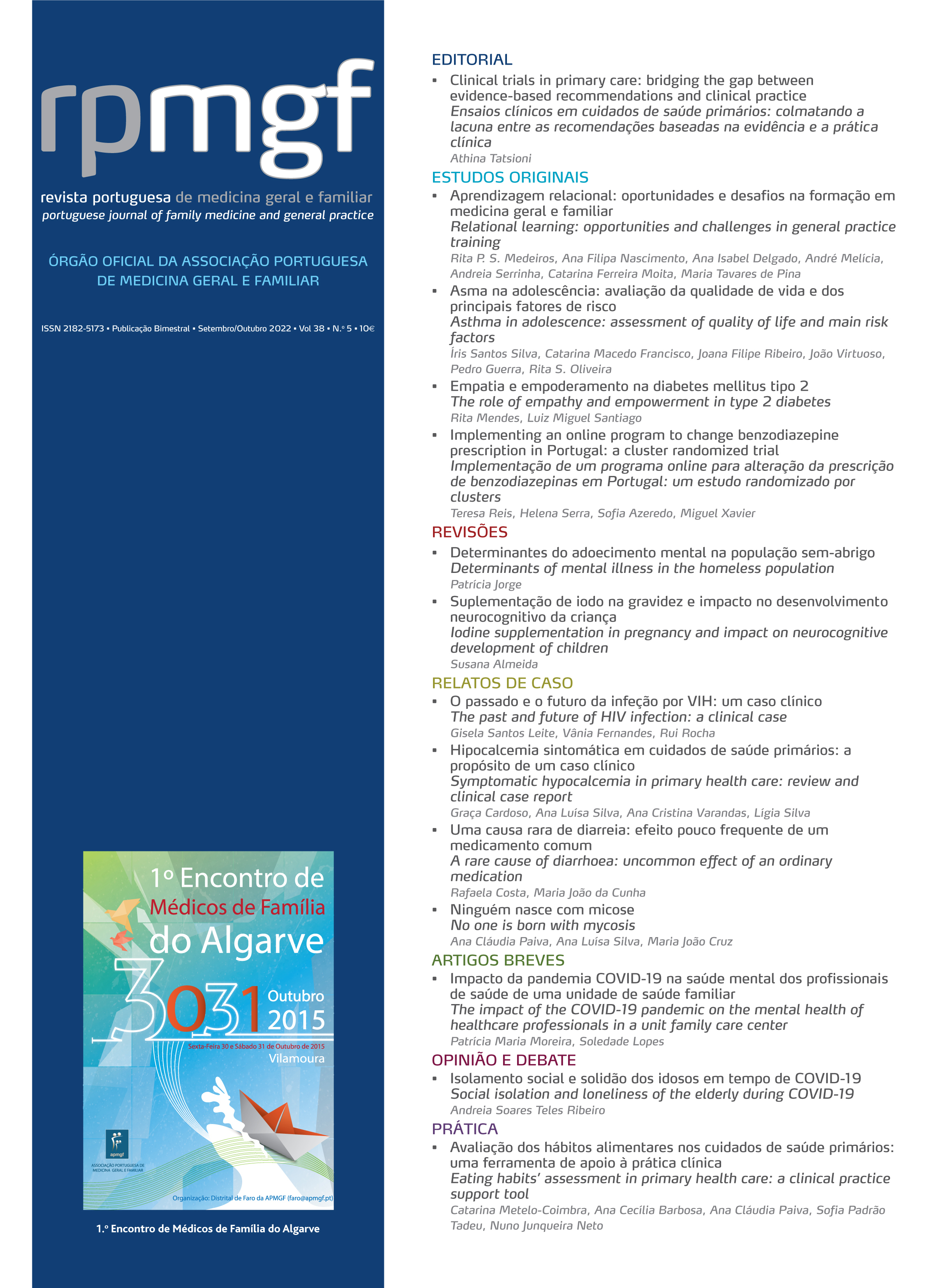The past and future of HIV infection: a clinical case
DOI:
https://doi.org/10.32385/rpmgf.v38i5.13121Keywords:
HIV, Kaposi syndrome, Acute myocardial infarctionAbstract
The prognosis of the human immunodeficiency virus (HIV) infected patients has significantly improved over the last decades. On the one hand, with the development of antiretroviral therapy (ART), Kaposi sarcoma (KS) has become a rare complication. On the other hand, with the increase in life expectancy of this population, an increased risk of cardiovascular diseases, such as acute myocardial infarction (AMI), persists despite ART and that cannot be fully explained by traditional cardiovascular risk factors. The authors describe a case of an HIV-infected young male, without consistent ART, with a recent diagnosis of KS and AMI. This article highlights the facts that may have led to the occurrence of these diseases, showing that KS is not a disease of the past and demonstrating the risk of cardiovascular diseases in HIV-infected patients.
Downloads
References
European Centre for Disease Prevention and Control/WHO Regional Office for Europe. HIV/AIDS surveillance in Europe 2021-2020 data [homepage]. Stockholm: ECDC; 2021. Available from: https://www.ecdc.europa.eu/en/publications-data/hiv-aids-surveillance-europe-2021-2020-data
Samji H, Cescon A, Hogg RS, Modur SP, Althoff KN, Buchacz K, et al. Closing the gap: increases in life expectancy among treated HIV-positive individuals in the United States and Canada. PLoS One. 2013;8(12):e81355.
Deeks SG, Overbaugh J, Phillips A, Buchbinder S. HIV infection. Nat Rev Dis Primers. 2015;1:15035.
Radu O, Pantanowitz L. Kaposi sarcoma. Arch Pathol Lab Med. 2013;137(2):289-94.
Mocroft A, Kirk O, Clumeck N, Gargalianos-Kakolyris P, Trocha H, Chentsova N, et al. The changing pattern of Kaposi sarcoma in patients with HIV, 1994-2003: the EuroSIDA study. Cancer. 2004;100(12):2644-54.
So-Armah K, Freiberg MS. HIV and cardiovascular disease: update on clinical events, special populations, and novel biomarkers. Curr HIV/AIDS Rep. 2018;15(3):233-44.
Hsue PY, Waters DD. HIV infection and coronary heart disease: mechanisms and management. Nat Rev Cardiol. 2019;16(12):745-59.
Shahbaz S, Manicardi M, Guaraldi G, Raggi P. Cardiovascular disease in human immunodeficiency virus infected patients: a true or perceived risk? World J Cardiol. 2015;7(10):633-44.
Calza L. HIV infection and myocardial infarction. Curr HIV Res. 2016;14(6):456-65.
Marcus JL, Neugebauer RS, Leyden WA, Chao CR, Xu L, Quesenberry Jr CP, et al. Use of abacavir and risk of cardiovascular disease among HIV-infected individuals. J Acquir Immune Defic Syndr. 2016;71(4):413-9.
Currier JS. Management of cardiovascular risk (including dyslipidemia) in patients with HIV. UpToDate [Internet]; 2020 [updated 2021 Feb 11; cited 2022 May 6]. Available from: https://www.uptodate.com/contents/management-of-cardiovascular-risk-including-dyslipidemia-in-patients-with-hiv
Delabays B, Cavassini M, Damas J, Beuret H, Calmy A, Hasse B, et al. Cardiovascular risk assessment in people living with HIV compared to the general population. Eur J Prev Cardiol. 2022;29(4):689-99.
Currier JS. Epidemiology of cardiovascular disease and risk factors in patients with HIV. UpToDate [Internet]; 2021 [updated 2021 Sep 14; cited 2020 Sep 20]. Available from: https://www.uptodate.com/contents/epidemiology-of-cardiovascular-disease-and-risk-factors-in-patients-with-hiv.
SCORE2 working group and ESC Cardiovascular risk collaboration. SCORE2 risk prediction algorithms: new models to estimate 10-year risk of cardiovascular disease in Europe. Eur Heart J. 2021;42(25):2439-54.
Mach F, Baigent C, Catapano AL, Koskinas KC, Casula M, Badimon L, et al. 2019 ESC/EAS Guidelines for the management of dyslipidaemias: lipid modification to reduce cardiovascular risk. Eur Heart J. 2020;41(1):111-88.
Gonçalves PH, Uldrick TS, Yarchoan R. HIV-associated Kaposi sarcoma and related diseases. AIDS. 2017;31(14):1903-16.
American Cancer Society. Key statistics about Kaposi sarcoma [homepage]. ACS; 2020 [cited 2020 Sep 16]. Available from: https://www.cancer.org/cancer/kaposi-sarcoma/about/what-is-key-statistics.html
Facciolà A, Rullo EV, Ceccarelli M, D’Aleo F, Di Rosa M, Pinzone MR, et al. Kaposi’s sarcoma in HIV-infected patients in the era of new antiretrovirals. Eur Rev Med Pharmacol Sci. 2017;21(24):5868-9.
Groopman JE. AIDS-related Kaposi sarcoma: clinical manifestations and diagnosis. UpToDate [Internet]; 2022 [updated 2022 Oct 11; cited 2020 Sep 20]. Available from: https://www.uptodate.com/contents/aids-related-kaposi-sarcoma-clinical-manifestations-and-diagnosis
Downloads
Published
How to Cite
Issue
Section
License
Copyright (c) 2022 Portuguese Journal of Family Medicine and General Practice

This work is licensed under a Creative Commons Attribution-NonCommercial-NoDerivatives 4.0 International License.
The authors will assign to the RPMGF the sole right to publish and distribute the content of the manuscript specified in this declaration via physical, electronic, broadcasting or any other medium that may come into existence. They also grant the RPMGF the right to use and exploit this manuscript, in particular by assigning, selling or licensing its content. This permission is permanent and takes effect from the moment the manuscript is submitted, has the maximum duration allowed by applicable Portuguese or international law and is of worldwide scope. The authors further declare that this assignment is made free of charge. If the RPMGF informs the authors that it is not going to publish their manuscript, the exclusive assignment of rights ceases forthwith.
The authors authorise the RPMGF (or any entity it may appoint) to act on their behalf when it believes that copyright may have been infringed.





